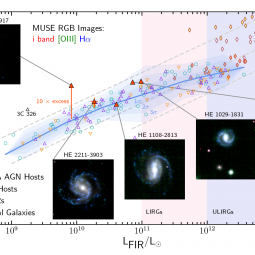By Joan Schmelz
How do astronomers understand galaxies that are so far away that they may appear as a simple point source, even when observed with the most powerful telescopes? One proven technique is to study local analogues, galaxies that might have similar properties but are close enough to resolve their structures. A study like this was underway when researchers discovered something extraordinary – their observation was 10 times stronger than predicted.
Recent results from SOFIA of a galaxy known as HE1353-1917 revealed that the emission of a spectral line of ionized carbon, [CII] at 158 µm, is 10 times stronger than that observed in similar galaxies.
Newborn stars are the most common heating source in galaxies and the main mechanism for [CII] excitation. Therefore, the [CII] line is often used as a proxy to estimate the star formation rate of a galaxy. However, other sources of energy such as the radiation and shocks produced by Active Galactic Nuclei (AGN) may contribute significantly to the [CII] emission, thereby breaking the correlation between the line strength and star formation rate. The SOFIA observations of HE1353-1917 reveal an extreme example of how this correlation can break down.
The supermassive black hole at the center of this galaxy appears to be the key to understanding this mystery. Current galaxy evolution scenarios imply that the activity of the central object can regulate star formation and play a key role through the entire lifetime of galaxy. The Close AGN Reference Survey (CARS) explores this intimate AGN – host galaxy relation in detail by combining observations at many different wavelengths.
The research team observed the [CII] line in a sample of five AGNs with SOFIA’s Far Infrared Field-Imaging Line Spectrometer (FIFI-LS). Team members were astonished to discover that the galaxy with the smallest star formation rate had the brightest [CII] line. In fact, in HE1353-1917, an exceptionally high fraction (5%) of the total far-infrared radiation is emitted solely through the [CII] line.
While all five host galaxies in the sample have similar stellar masses, metallicities, and AGN luminosities, HE1353-1917 differs from the others in its peculiar configuration. The orientation of the central AGN engine is such that most of its released energy is deposited into the cold gas disc of its host galaxy. A detailed multi-wavelength analysis revealed that a radio jet is launching a multi-phase outflow from the AGN into the surroundings. With FIFI-LS, researchers were able to confirm that the excess of the [CII] emission is indeed clearly confined to the center of this enigmatic galaxy where this AGN feedback is in action.
SOFIA observations are improving our understanding of the [CII] emission in galaxies. They provide a vital contribution to the interpretation of ongoing and future studies of distant galaxies where the [CII] line is redshifted into the radio band observed with the Atacama Large Millimeter Array (ALMA). These galaxies are so far away that they generally appear only as a point source in ALMA observations. Without the structural context provided by nearby galaxies like HE1353-1917, observers might continue to use the [CII] line strength as a simplistic proxy for the star formation rate, unaware of how other energy sources may be contributing to the [CII] emission.
These SOFIA FIFI-LS observations are establishing a local reference for high-redshift studies and launching new methods of investigating the details of AGN feedback across cosmic history.
